For Enthusiasts - Metro
Prague Metro
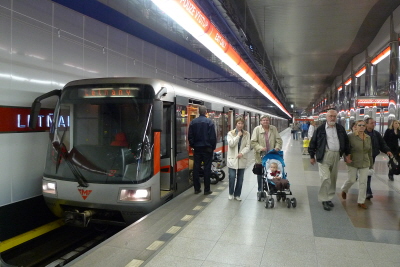
There are three metro lines designated A, B and C (see plan), with frequent services operating from approximately 0500 until midnight every day. The first line started in 1974 and there have been many extensions since. In 2008 Line C was extended to Letnany where the terminus was laid out on a large greenfield site with extensive car parking and a bus station. Construction of a 6 km extension of Line A beyond Dejvická to Nemocnice Motol (the University Hospital) started in 2010 and the line opened in April 2015, with three intermediate stations.
The first phase of new Line D is under contruction, serving the south of the city.
The standard fare scale applies to all metro, tram and bus lines as explained on the Getting Around page.
Photo: The modern station at Letnany with a type M1 train.
Websites about the Metro
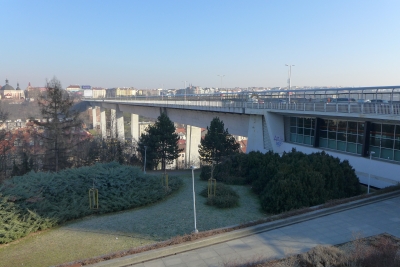
An english-language enthusiast website called simply Prague Metro has a great deal of information, including location plans and photographs of the stations, as well as opening dates for each section and brief details of rolling stock.
The serious enthusiast will also want to study Metroweb.cz, an extremely comprehensive site in Czech and English. The link takes you to the English version, as much of the site has been translated into English (for the Czech version click the Czech flag on the main page). Amongst the many features are detailed fleet lists, historical and technical information, track maps, details of signalling, and hundreds of photos. There are also some videos, and a nice touch is a sound library with MP3 files of station announcements - very useful for learning the correct pronunciation of station names. For those interested in the future expansion of the system, there are many maps, plans and drawings, including artist impressions of future planned stations.
Other websites with pages in English about the Prague metro include urbanrail.net (the map includes planned line D) and doprava.cx.
Photo: Looking across the Nusle Bridge from Vyšehrad station.
What to look for
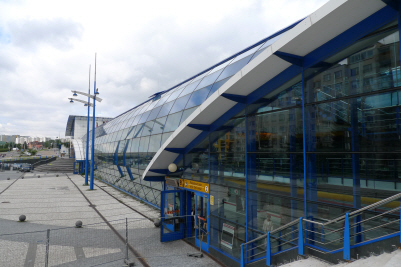
Most of the metro is underground or under cover, so unlike Paris, Berlin or Hamburg there are no opportunities for sightseeing from the metro! One interesting exception is the eastern end of Line A which is above ground for the last 500 metres or so into Depo Hostivar. Here the line terminates literally inside the metro depot, where the former washing bay has been converted into terminal platforms. The depot itself opened in 1985, with trains having a long empty run from Želivského, end of the line until Strašnická opened in 1987. Nearer to the depot, Skalka opened in 1990 and was intended to be the last station, but from 2006 alternate trains were extended to Depo Hostivar, where park and ride facilities and a small bus station were inaugurated. Not far away are the OZM metro workshops, Hostivar bus depot and works, and the main tram workshops located at the end of tram route 16.
Another unusual section is the eastern end of Line B from the penultimate station, Rajská zahrada, to the end of the line at Cerny Most. This part of the line is raised above ground but is totally enclosed in a tube-like structure. On top is a walkway, so you can actually walk between the two stations literally above the tracks. Even if you don't fancy the walk, it's worth stopping off at the impressive looking Rajská zahrada station, probably the most interesting on the system. The whole station is above ground, with the eastbound platform being at ground level with level access directly from outside. The westbound platform is at a higher level reached by steps. Cerny Most is a more conventional station, although bus and coach enthusiasts will find the large and busy bus station of interest, hosting not only urban and out-of-town services, but also several operators running express coaches to Liberec.
Photo above: Rajská zahrada station.
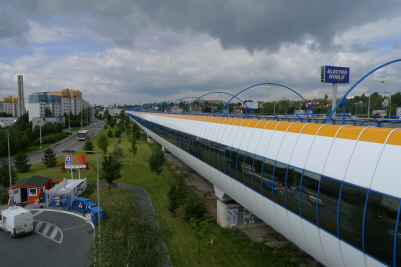
The western end of Line B to Zlicin also has a section raised above ground in an enclosed tube, between Lužiny and Hurka. This is an impressive looking structure from a distance, sweeping across the landscape (though I guess some may consider it an eyesore). Travelling through it by train, however, is not much different from being underground and you could easily miss it altogether if it wasn't for the glimpses of daylight through the small dirty windows as they flash by.
Line C crosses the Nusle Valley below the road surface of the Nusle Bridge (Nuselský Most), completed in 1973. This is situated immediately north of Vyšehrad station, which is partially incorporated into the southern end of the bridge structure. The station itself has windows on either side, but the track over the bridge is completely enclosed in concrete.
The western terminus of Line A, Nemocnice Motol, is partly at street level. This was opened in April 2015.
Photo right: Line B between Rajská zahrada and Cerny Most, with walkway on top.
Rolling Stock
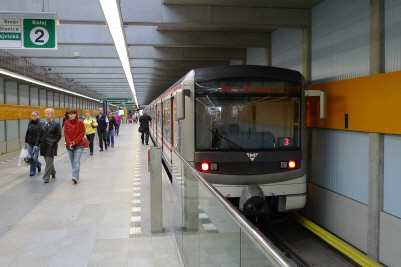
There are broadly two types of train operating on the Prague metro, the modern M1 cars built by Adtranz/Siemens between 1997 and 2002, and older trains designated 81-71M which are modernised versions of 81-71 units originally built in Russia and delivered between 1977 and 1990. The original Ecs units built for the first metro lines in 1973-76 were based on an outdated Russian design and were withdrawn in the late 1990s, although one 3-car train has been retained for preservation.
The M1 trains are formed into 53 5-car sets and run the entire service on Line C, based at Kacerov depot. The other two lines run the 81-71M type of train in 5-car sets, with 41 sets allocated to Hostivar depot for Line A, and 52 sets at Zlicin depot for Line B. Modernisation of the 81-71M units took place between 1995 and 2010 and, needless to say, there are a number of sub-series with variations in detail.
Photo: Depo Hostivar station, terminus of Line A, with a 81-71M train